Difference between revisions of "Data import"
| (70 intermediate revisions by 9 users not shown) | |||
| Line 1: | Line 1: | ||
= User/Device/DID import = | = User/Device/DID/CLI import = | ||
You must import the data in the following order '''from CSV files''': | You must import the data in the following order '''from CSV files''': | ||
| Line 7: | Line 5: | ||
1. Users data<br> | 1. Users data<br> | ||
2. Devices data<br> | 2. Devices data<br> | ||
3. DIDs data | 3. DIDs data<br> | ||
'''Import Devices from CSV''' link is disabled while Users data is not imported. '''Import DIDs from CSV''' link is disabled while Devices data is not imported. | |||
CLIs data can be imported for already existing Devices by Device ID or for just imported Devices by Temporary Device ID (which is in '''SETTINGS -> Users -> Import'''). | |||
Functionality is available for '''Admin''' and '''Reseller'''. | |||
== CSV file format == | == CSV file format == | ||
You can upload your data from a CSV file | <br> | ||
1. Each record is started | '''Please note that such details like tariff, LCR, IDs should be specified in csv instead names.''' | ||
2. Each piece of record information is separated | |||
3. Text is enclosed | Example you have LCR called "My first LCR" this LCR ID is 2. You should specify in csv 2, but not My first LCR. | ||
4. Numbers are written without inverted commas (example: 4)<br> | |||
5. | Other way if you will not specify ID system will not find it. | ||
You can upload your data from a CSV file that has the following structure:<br> | |||
1. Each record is started in a new line.<br> | |||
2. Each piece of record information is separated by commas (see the example).<br> | |||
3. Text is enclosed within inverted commas (for example: "name").<br> | |||
4. Numbers are written without inverted commas (for example: 4).<br> | |||
5. The first line can be used for your own needs, such as for naming each field of information. '''If you use this line, do not select the "include first line?" option when asked. | |||
''' | ''' | ||
'''For example:'''<br> | '''For example:'''<br> | ||
We have a | We have a CSV file named '''example.csv''' with the contents: | ||
"id", "username", "password", "e-mail"<br> | |||
1, "username1", "verySecretPassword", "example@example.com"<br> | |||
2, "username2", "34r34r4232", "example2@example.com"<br> | |||
3, "username3", "23er29923wjwe", "example3@example.com"<br> | |||
'''Explanation:'''<br> | |||
The '''first line''' is used in this case for naming the fields, so '''when asked, do not select the "include first line?"''' option. (If you won't use the first line for '''naming the fields''', please do select '''"include first line?")'''<br> | |||
2, | The other three lines (starting 1, 2, 3) are for data records. Each record (the first one is: 1, "username1", "verySecretPassword", "example@example.com") represents:<br> | ||
1 - user id.<br> | |||
"username1" - user's username.<br> | |||
"verySecretPassword" - user's password.<br> | |||
1 - user id<br> | "example@example.com" - user's e-mail.<br> | ||
"username1" - user's username<br> | |||
"verySecretPassword" - user's password<br> | |||
"example@example.com" - user's e-mail<br> | |||
Your CSV file can have any number of lines with any number of fields ('''each line must have the same number of fields'''). | Your CSV file can have any number of lines with any number of fields ('''each line must have the same number of fields'''). | ||
P.S. The file should not have any other symbols | P.S. The file should not have any other symbols than those mentioned above. Be careful, as some editors can add their own formatting symbols. In Windows we recommend using Notepad, and in Linux: gedit, kedit, nano. | ||
'''Here are some examples:''' | |||
'''Users CSV file example:'''<br> | |||
38,2,0,"NULL","NULL",TRUE,"11420471-2-03","Example ZRt","Example ZRt","example example. 11","76/356-650","example@example.hu",04/06/07 01:48 PM," ","en",97,20,0,FALSE,TRUE,5,0,04/06/07,"NULL","NULL",0,FALSE,04/06/07,"Lajosmi",6050,1,0,1,1,TRUE,"NULL","NULL",3<br><br> | |||
45,2,0,"95757bfa00bf85b17921d709b5af0234","NULL",TRUE,"12969247-2-03","Example Ákos","Example Example, Kft","Example's 38","70/235-45-89","example@example2.hu",04/06/09 11:28 AM," ","en",97,20,0,FALSE,TRUE,5,0,04/07/09,"NULL","NULL",0,FALSE,04/06/09,"Kecexample",6000,1,0,1,1,TRUE,"NULL","NULL","NULL"<br><br> | |||
2138,2,0,"cc1b3ae8986559b10786d6ea73912bd5","NULL",TRUE,"11871633-2-03","Kos Tas","Ks Kft","Alsó ast","20/229-36-78","pli@example.hu",12/13/07 09:42 AM," ","en",97,20,0,FALSE,TRUE,5,0,12/13/07,"NULL","NULL",0,FALSE,12/13/07,"Sirly",6031,1,0,1,1,TRUE,"NULL","NULL","NULL" | |||
In the first column is a Temporary User's ID; the other columns represent other data. As mentioned above, it does not matter in which order your data is represented in the CSV file. It only matters that each column (the data between commas) represents the same data value (id, email, password or other). | |||
"Blocked" column accepts values "1", "y", "true", "yes", "block" or "blocked". These values will result in imported User being blocked. Any other or empty value will result in User not being Blocked. | |||
'''Devices CSV file example:''' | |||
38,38,76824435,"3676586421","asd dsa u.12","jamaica","7ewfw@sip.example.com",TRUE,"dynamic","sip",TRUE,"NULL","NULL","NULL","NULL","NULL","NULL","NULL","NULL","NULL","NULL","NULL","NULL","NULL","NULL" <br> | |||
45,45,76846301,"3676886421","fgh hgf u.","ergerSiP","76886421@sip.example.com",TRUE,"dynamic","sip",TRUE,"NULL","NULL","NULL","NULL","NULL","NULL","NULL","NULL","NULL","NULL","NULL","NULL","NULL","NULL"<br> | |||
2138,2138,76505921,"3676505921","jkl lkj u.12","treK","6654@sip.example.com",FALSE,"dynamic","sip",TRUE,"NULL",FALSE,FALSE,10,FALSE,FALSE,FALSE,FALSE,FALSE,FALSE,FALSE,FALSE,,FALSE | |||
The first column here represents "id", the second "user_id", and the others represent other data. YOUR ORDER CAN BE DIFFERENT. The main thing is that each type of data (email, password, id...) must be in the same column. When you are asked to provide data when importing, be sure to assign the correct data from CSV for each column and MOR will know which column represents which data. | |||
'''Dids CSV file example:''' | |||
37067531061,38,38<br> | |||
37065431061,45,22<br> | |||
37062431031,2138,2138<br> | |||
In this example I have used the first column for DID, the second for Temporary User ID, and the third for Temporary Device ID. Your data order can be completely different. You just need to select the correct values when asked. | |||
== Importing data == | |||
Firstly, from the MOR Graphical User Interface (GUI), navigate to: '''Settings -> Users -> Import''', as in the picture: | |||
<br><br> | |||
[[Image:Imports_menu.png|alt import_menu]] | |||
<br><br> | |||
=== Temporary User ID & Temporary Device ID === | === Temporary User ID & Temporary Device ID === | ||
These fields are necessary to map DIDs to Devices and Devices to Users. | These fields are necessary to map DIDs to Devices and Devices to Users. | ||
Temporary IDs can be integer digits only. | |||
Example: | Example: | ||
You have some other system with some user_ids, device_ids, | You have some other system with some user_ids, device_ids, DID_ids. You export them into CSV files. The relations between them are kept by these IDs, so importing them to MOR will keep these relations. | ||
First you need to import a User with some temporary ID, then make sure this ID is near each Device you are trying to import. Select this ID as Temporary User ID when importing Devices. That way these devices will be mapped to this User. | |||
The "Clear temporary information" button will clear Users and Devices temporary IDs. Use it only when import procedures are completed and you want to start over with a new set of Users and Devices. | |||
== Importing users == | |||
To import users, click on the "Import Users from CSV" link: | |||
<br><br> | |||
[[Image:Imports_users_selection.png|alt Imports_users_selection]] | |||
<br><br> | |||
Now locate the CSV file in your local system by clicking the "Browse" button. As indicated above, don't click the "Include first line?" checkbox if you have used the first line for commenting on the fields. | |||
<br><br> | |||
[[Image:Upload_csv_file.png|alt upload_csv_file]] | |||
<br><br> | |||
'''Click on the "Upload file" button.''' | |||
In next menu, please fill in the requested data (you should select the correct field from your CSV file). '''You must select a field for each selection box marked with an asterisk (*) symbol'''. Having finished, press the "Assign columns" button. | |||
<br><br> | |||
[[Image:User import.png|alt select_fields]] | |||
<br><br> | |||
On the next page, check whether all the data was assigned correctly. If not, click the "Back" button and correct the mistakes. If all the data was assigned correctly, click the "Confirm columns" button. After the "Columns assigned" notification informs you that data successfully imported. | |||
'''NOTE:''' When you are going to import CSV file, which includes Tariff and/or LCR, the '''IDs''' of Tariff and LCR should be specified in CSV file. | |||
Where to find ID of Tariff or LCR? Just go to some of them and press on edit icon, where Browser navigator bar will show full link with location, last number is ID. | |||
'''NOTE:''' In the Payment type section you have to select do you want to upload prepaid or postpaid user. In CSV file 1 stand for postpaid user, 0 for prepaid user. By default, if Payment type is not select all users will be uploaded as prepaid users. | |||
Having completed all these steps, you should see a page similar to this: | |||
<br><br> | |||
[[Image:Users_imported.png|alt Users_imported]] | |||
<br><br> | |||
== Importing devices == | |||
Click on the "Import Devices from CSV" link and follow the same procedure for uploading a CSV file as in the "Importing users" section. That is, locate the CSV file in your local system by clicking the "Browse" button. As stated before, don't click the "Include first line?" checkbox if you have used the first line for commenting on the fields. Click on the "Upload file" button. Now you should see a menu similar to this: | |||
<br><br> | |||
[[Image:Device_selection.png|alt device_selection]] | |||
<br><br> | |||
In this menu, once again select a matching field from your CSV file for each selection box. '''It is very important to correctly select Temporary User ID and Temporary Device ID, because these fields are necessary to map DIDs to Devices and Devices to Users.''' | |||
'''NOTE:''' When you are going to import CSV file, which includes Location, the '''name''' of Location should be specified in CSV file. | |||
Having finished selecting the fields, press the "Assign columns" button. | |||
Once the columns are assigned, check whether all the data is correct. If not, press the "Back" button and correct the mistakes. Now, if you haven't made any mistakes, you should see two tables similar to these: | |||
<br><br> | |||
[[Image:Users_devices_tables.png|alt users_devices]] | |||
<br><br> | |||
== Importing DIDs == | |||
Click on the "Import Devices from CSV" link and follow the same steps for uploading a CSV file as in the "Importing users" section. That is, | |||
locate the CSV file in your local system by clicking the "Browse" button. As stated before, don't click on the "Include first line?" checkbox if you have used the first line for commenting on the fields. Click on the "Upload file" button. Now you should see a menu similar to this: | |||
<br><br> | |||
[[Image:Dids select.png|alt dids_selection]] | |||
<br><br> | |||
Select all matching fields from your CSV here. It is very IMPORTANT to select the CORRECT Temporary User ID and Temporary Device ID! Having selected everything correctly, click the "Assign columns" button. In the next page, if all imported data is assigned correctly, click the "Confirm columns" button. If you haven't made any mistakes, you should now see a "DIDs successfully imported" message. | |||
== Importing CLIs == | |||
<!-- This option is available starting with [[MOR X3]]--> | |||
CLIs data can be imported for already existing Devices by Device ID or for just imported Devices by Temporary Device ID. | |||
Click on the "Import CLIs from CSV" link and follow the same steps for uploading a CSV file as in the "Importing users" section. That is, locate the CSV file in your local system by clicking the "Browse" button. As stated before, don't click on the "Include first line?" checkbox if you have used the first line for commenting on the fields. Click on the "Upload file" button. Now you should see a menu similar to this: | |||
<br><br> | |||
[[Image:CLIs select.png|alt clis_selection]] | |||
<br><br> | |||
Select all matching fields from your CSV here. It is very IMPORTANT to select the CORRECT Device ID (if it is selected "Use Device ID") or Temporary Device ID(if it is selected "Use Temporary Device ID")! Having selected everything correctly, click the "Assign columns" button. In the next page, if all imported data is assigned correctly, click the "Confirm columns" button. If you haven't made any mistakes, you should now see a "CLIs successfully imported" message. | |||
You can now check whether all your data has been imported. | |||
To check users, go to: '''SETTINGS –> Users'''. | |||
To check devices, go to: '''SETTINGS –> Users –> Devices'''. | |||
To check DIDs, go to: '''SETTINGS –> Billing –> DIDs'''. | |||
To check CLIs, go to: '''SETTINGS –> Billing –> Devices –> CLIs'''. | |||
<br><br> | |||
[[Image:Dids devices users.png|alt dids_devices_users]] | |||
<br><br> | |||
= Explanation of IDs = | |||
Many users find it difficult to understand what User_ID or Device_ID mean in Data Import. | |||
These are temporary IDs created only for import purposes. '''These IDs have NO relation to User ID/Device ID in the Users/Devices windows of the MOR system.''' | |||
The workflow of Import is: | |||
1. We have Users/Devices/DIDs. | |||
2. We create a separate file with Users and add a unique ID to every User. The ID is NOT related to User ID in MOR DB/GUI. | |||
3. We create a separate file with Devices and add a unique ID to every Device. The ID is NOT related to Device ID in MOR DB/GUI. Near each device we add a temporary User ID from previous file, which shows which Device belongs to which User. | |||
4. We create a separate file with DIDs and near each DID add a User_ID/Device_ID that shows which DID belongs to which User/Device. | |||
5. We import the User file, and MOR remembers the temporary User_ID. | |||
6. We import the Device file, and MOR remembers the temporary Device_ID and checks the User_ID for such Devices which have a User_ID near them in the file. It assigns this Device to the appropriate User. | |||
7. We import the DID file. MOR checks the Device_ID/User_ID in the DIDs file and assigns a DID to this Device/User. | |||
8. We import the CLI file. If during import there is selected "Use Temporary Device ID " MOR checks the Device_ID in the CLIs file and assigns a CLI to this Device. If it is checked "Use Device ID" MOR checks the ID of Device in the CLIs file and assigns a CLI to this Device | |||
NOTE: in all processes, only a TEMPORARY User_ID/Device_ID is used. In the database, Users' ID/Devices' ID are not used directly. They have no relation to the User_ID/Device_ID from import files. | |||
= See also = | |||
* [[Export Users and Devices]] | |||
Latest revision as of 10:31, 9 June 2023
User/Device/DID/CLI import
You must import the data in the following order from CSV files:
1. Users data
2. Devices data
3. DIDs data
Import Devices from CSV link is disabled while Users data is not imported. Import DIDs from CSV link is disabled while Devices data is not imported.
CLIs data can be imported for already existing Devices by Device ID or for just imported Devices by Temporary Device ID (which is in SETTINGS -> Users -> Import).
Functionality is available for Admin and Reseller.
CSV file format
Please note that such details like tariff, LCR, IDs should be specified in csv instead names.
Example you have LCR called "My first LCR" this LCR ID is 2. You should specify in csv 2, but not My first LCR.
Other way if you will not specify ID system will not find it.
You can upload your data from a CSV file that has the following structure:
1. Each record is started in a new line.
2. Each piece of record information is separated by commas (see the example).
3. Text is enclosed within inverted commas (for example: "name").
4. Numbers are written without inverted commas (for example: 4).
5. The first line can be used for your own needs, such as for naming each field of information. If you use this line, do not select the "include first line?" option when asked.
For example:
We have a CSV file named example.csv with the contents:
"id", "username", "password", "e-mail"
1, "username1", "verySecretPassword", "example@example.com"
2, "username2", "34r34r4232", "example2@example.com"
3, "username3", "23er29923wjwe", "example3@example.com"
Explanation:
The first line is used in this case for naming the fields, so when asked, do not select the "include first line?" option. (If you won't use the first line for naming the fields, please do select "include first line?")
The other three lines (starting 1, 2, 3) are for data records. Each record (the first one is: 1, "username1", "verySecretPassword", "example@example.com") represents:
1 - user id.
"username1" - user's username.
"verySecretPassword" - user's password.
"example@example.com" - user's e-mail.
Your CSV file can have any number of lines with any number of fields (each line must have the same number of fields).
P.S. The file should not have any other symbols than those mentioned above. Be careful, as some editors can add their own formatting symbols. In Windows we recommend using Notepad, and in Linux: gedit, kedit, nano.
Here are some examples:
Users CSV file example:
38,2,0,"NULL","NULL",TRUE,"11420471-2-03","Example ZRt","Example ZRt","example example. 11","76/356-650","example@example.hu",04/06/07 01:48 PM," ","en",97,20,0,FALSE,TRUE,5,0,04/06/07,"NULL","NULL",0,FALSE,04/06/07,"Lajosmi",6050,1,0,1,1,TRUE,"NULL","NULL",3
45,2,0,"95757bfa00bf85b17921d709b5af0234","NULL",TRUE,"12969247-2-03","Example Ákos","Example Example, Kft","Example's 38","70/235-45-89","example@example2.hu",04/06/09 11:28 AM," ","en",97,20,0,FALSE,TRUE,5,0,04/07/09,"NULL","NULL",0,FALSE,04/06/09,"Kecexample",6000,1,0,1,1,TRUE,"NULL","NULL","NULL"
2138,2,0,"cc1b3ae8986559b10786d6ea73912bd5","NULL",TRUE,"11871633-2-03","Kos Tas","Ks Kft","Alsó ast","20/229-36-78","pli@example.hu",12/13/07 09:42 AM," ","en",97,20,0,FALSE,TRUE,5,0,12/13/07,"NULL","NULL",0,FALSE,12/13/07,"Sirly",6031,1,0,1,1,TRUE,"NULL","NULL","NULL"
In the first column is a Temporary User's ID; the other columns represent other data. As mentioned above, it does not matter in which order your data is represented in the CSV file. It only matters that each column (the data between commas) represents the same data value (id, email, password or other).
"Blocked" column accepts values "1", "y", "true", "yes", "block" or "blocked". These values will result in imported User being blocked. Any other or empty value will result in User not being Blocked.
Devices CSV file example:
38,38,76824435,"3676586421","asd dsa u.12","jamaica","7ewfw@sip.example.com",TRUE,"dynamic","sip",TRUE,"NULL","NULL","NULL","NULL","NULL","NULL","NULL","NULL","NULL","NULL","NULL","NULL","NULL","NULL"
45,45,76846301,"3676886421","fgh hgf u.","ergerSiP","76886421@sip.example.com",TRUE,"dynamic","sip",TRUE,"NULL","NULL","NULL","NULL","NULL","NULL","NULL","NULL","NULL","NULL","NULL","NULL","NULL","NULL"
2138,2138,76505921,"3676505921","jkl lkj u.12","treK","6654@sip.example.com",FALSE,"dynamic","sip",TRUE,"NULL",FALSE,FALSE,10,FALSE,FALSE,FALSE,FALSE,FALSE,FALSE,FALSE,FALSE,,FALSE
The first column here represents "id", the second "user_id", and the others represent other data. YOUR ORDER CAN BE DIFFERENT. The main thing is that each type of data (email, password, id...) must be in the same column. When you are asked to provide data when importing, be sure to assign the correct data from CSV for each column and MOR will know which column represents which data.
Dids CSV file example:
37067531061,38,38
37065431061,45,22
37062431031,2138,2138
In this example I have used the first column for DID, the second for Temporary User ID, and the third for Temporary Device ID. Your data order can be completely different. You just need to select the correct values when asked.
Importing data
Firstly, from the MOR Graphical User Interface (GUI), navigate to: Settings -> Users -> Import, as in the picture:
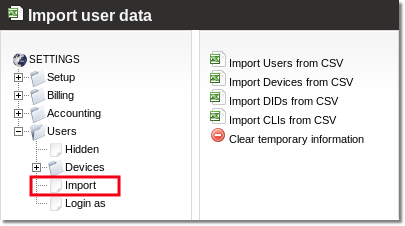
Temporary User ID & Temporary Device ID
These fields are necessary to map DIDs to Devices and Devices to Users.
Temporary IDs can be integer digits only.
Example:
You have some other system with some user_ids, device_ids, DID_ids. You export them into CSV files. The relations between them are kept by these IDs, so importing them to MOR will keep these relations.
First you need to import a User with some temporary ID, then make sure this ID is near each Device you are trying to import. Select this ID as Temporary User ID when importing Devices. That way these devices will be mapped to this User.
The "Clear temporary information" button will clear Users and Devices temporary IDs. Use it only when import procedures are completed and you want to start over with a new set of Users and Devices.
Importing users
To import users, click on the "Import Users from CSV" link:
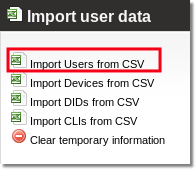
Now locate the CSV file in your local system by clicking the "Browse" button. As indicated above, don't click the "Include first line?" checkbox if you have used the first line for commenting on the fields.
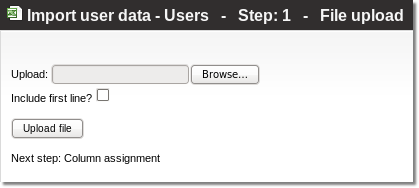
Click on the "Upload file" button.
In next menu, please fill in the requested data (you should select the correct field from your CSV file). You must select a field for each selection box marked with an asterisk (*) symbol. Having finished, press the "Assign columns" button.
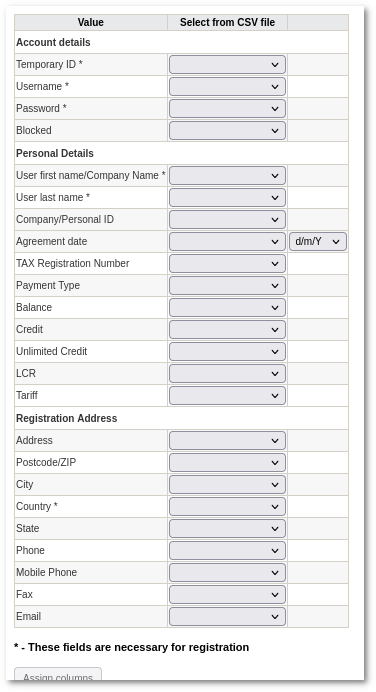
On the next page, check whether all the data was assigned correctly. If not, click the "Back" button and correct the mistakes. If all the data was assigned correctly, click the "Confirm columns" button. After the "Columns assigned" notification informs you that data successfully imported.
NOTE: When you are going to import CSV file, which includes Tariff and/or LCR, the IDs of Tariff and LCR should be specified in CSV file.
Where to find ID of Tariff or LCR? Just go to some of them and press on edit icon, where Browser navigator bar will show full link with location, last number is ID.
NOTE: In the Payment type section you have to select do you want to upload prepaid or postpaid user. In CSV file 1 stand for postpaid user, 0 for prepaid user. By default, if Payment type is not select all users will be uploaded as prepaid users.
Having completed all these steps, you should see a page similar to this:
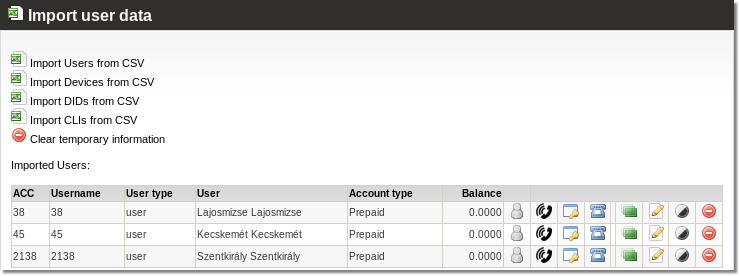
Importing devices
Click on the "Import Devices from CSV" link and follow the same procedure for uploading a CSV file as in the "Importing users" section. That is, locate the CSV file in your local system by clicking the "Browse" button. As stated before, don't click the "Include first line?" checkbox if you have used the first line for commenting on the fields. Click on the "Upload file" button. Now you should see a menu similar to this:
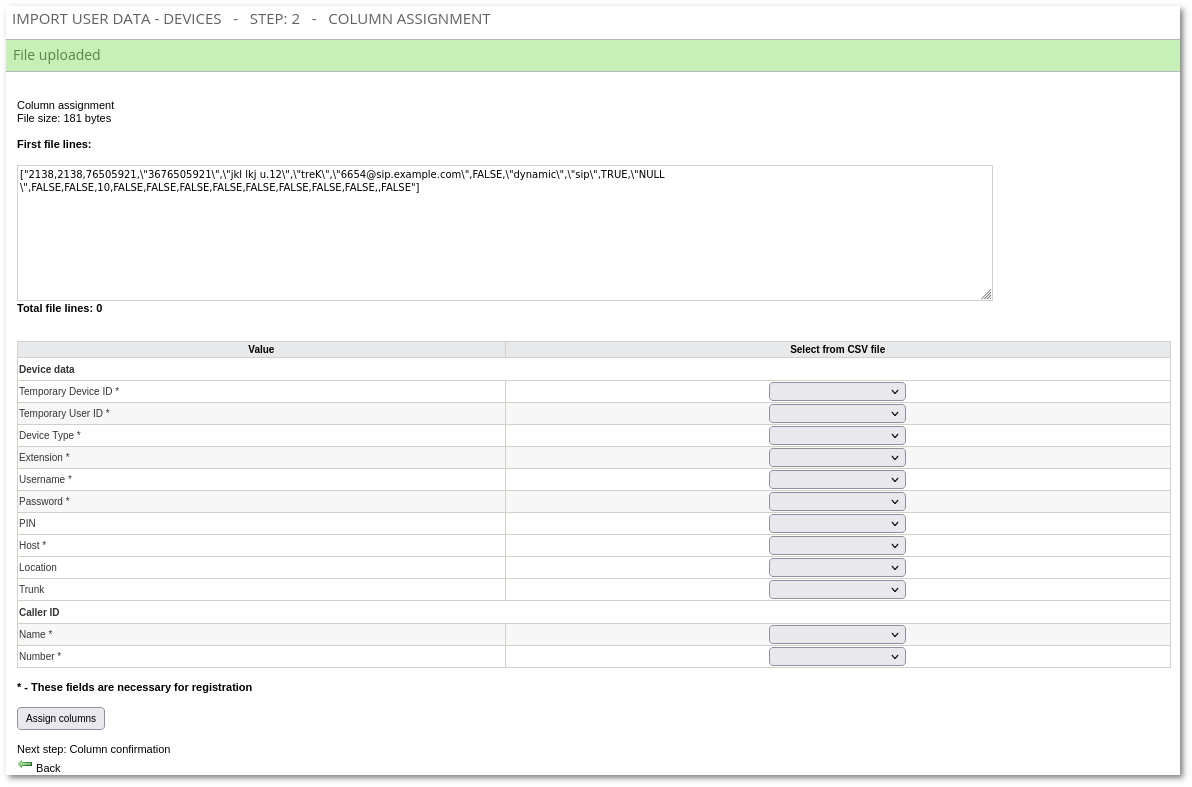
In this menu, once again select a matching field from your CSV file for each selection box. It is very important to correctly select Temporary User ID and Temporary Device ID, because these fields are necessary to map DIDs to Devices and Devices to Users.
NOTE: When you are going to import CSV file, which includes Location, the name of Location should be specified in CSV file.
Having finished selecting the fields, press the "Assign columns" button.
Once the columns are assigned, check whether all the data is correct. If not, press the "Back" button and correct the mistakes. Now, if you haven't made any mistakes, you should see two tables similar to these:
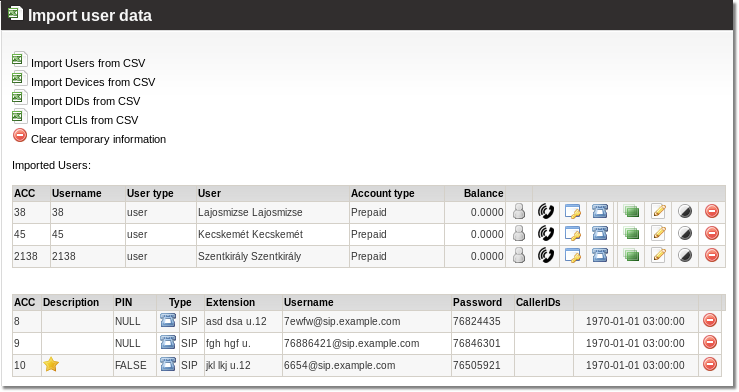
Importing DIDs
Click on the "Import Devices from CSV" link and follow the same steps for uploading a CSV file as in the "Importing users" section. That is,
locate the CSV file in your local system by clicking the "Browse" button. As stated before, don't click on the "Include first line?" checkbox if you have used the first line for commenting on the fields. Click on the "Upload file" button. Now you should see a menu similar to this:
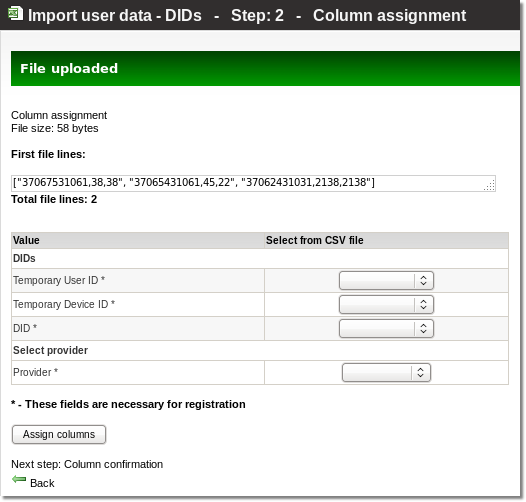
Select all matching fields from your CSV here. It is very IMPORTANT to select the CORRECT Temporary User ID and Temporary Device ID! Having selected everything correctly, click the "Assign columns" button. In the next page, if all imported data is assigned correctly, click the "Confirm columns" button. If you haven't made any mistakes, you should now see a "DIDs successfully imported" message.
Importing CLIs
CLIs data can be imported for already existing Devices by Device ID or for just imported Devices by Temporary Device ID.
Click on the "Import CLIs from CSV" link and follow the same steps for uploading a CSV file as in the "Importing users" section. That is, locate the CSV file in your local system by clicking the "Browse" button. As stated before, don't click on the "Include first line?" checkbox if you have used the first line for commenting on the fields. Click on the "Upload file" button. Now you should see a menu similar to this:
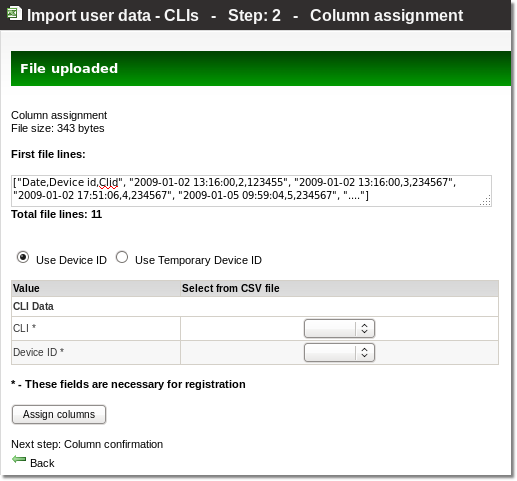
Select all matching fields from your CSV here. It is very IMPORTANT to select the CORRECT Device ID (if it is selected "Use Device ID") or Temporary Device ID(if it is selected "Use Temporary Device ID")! Having selected everything correctly, click the "Assign columns" button. In the next page, if all imported data is assigned correctly, click the "Confirm columns" button. If you haven't made any mistakes, you should now see a "CLIs successfully imported" message.
You can now check whether all your data has been imported.
To check users, go to: SETTINGS –> Users.
To check devices, go to: SETTINGS –> Users –> Devices.
To check DIDs, go to: SETTINGS –> Billing –> DIDs.
To check CLIs, go to: SETTINGS –> Billing –> Devices –> CLIs.
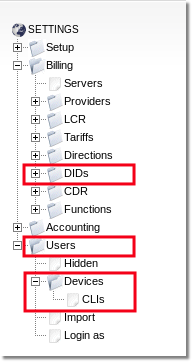
Explanation of IDs
Many users find it difficult to understand what User_ID or Device_ID mean in Data Import.
These are temporary IDs created only for import purposes. These IDs have NO relation to User ID/Device ID in the Users/Devices windows of the MOR system.
The workflow of Import is:
1. We have Users/Devices/DIDs.
2. We create a separate file with Users and add a unique ID to every User. The ID is NOT related to User ID in MOR DB/GUI.
3. We create a separate file with Devices and add a unique ID to every Device. The ID is NOT related to Device ID in MOR DB/GUI. Near each device we add a temporary User ID from previous file, which shows which Device belongs to which User.
4. We create a separate file with DIDs and near each DID add a User_ID/Device_ID that shows which DID belongs to which User/Device.
5. We import the User file, and MOR remembers the temporary User_ID.
6. We import the Device file, and MOR remembers the temporary Device_ID and checks the User_ID for such Devices which have a User_ID near them in the file. It assigns this Device to the appropriate User.
7. We import the DID file. MOR checks the Device_ID/User_ID in the DIDs file and assigns a DID to this Device/User.
8. We import the CLI file. If during import there is selected "Use Temporary Device ID " MOR checks the Device_ID in the CLIs file and assigns a CLI to this Device. If it is checked "Use Device ID" MOR checks the ID of Device in the CLIs file and assigns a CLI to this Device
NOTE: in all processes, only a TEMPORARY User_ID/Device_ID is used. In the database, Users' ID/Devices' ID are not used directly. They have no relation to the User_ID/Device_ID from import files.
